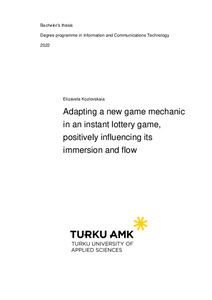Adapting a new game mechanic in an instant lottery game, positively influencing its immersion and flow
Kozlovskaia, Elizaveta (2022)
Kozlovskaia, Elizaveta
2022
All rights reserved. This publication is copyrighted. You may download, display and print it for Your own personal use. Commercial use is prohibited.
Julkaisun pysyvä osoite on
https://urn.fi/URN:NBN:fi:amk-2022060916967
https://urn.fi/URN:NBN:fi:amk-2022060916967
Tiivistelmä
Currently, the Finnish online gambling market is estimated to generate an annual gross revenue of €1.135 million. A large proportion of this market centers on instant lottery games that typically include basic digital scratch cards, merge, match three, or solitaire-based game mechanics. These types of games rely almost exclusively on extrinsic motivation (the hope of winning money) for their popularity. The aim of this thesis was to design and develop a proof of concept instant lottery game with an adapted (from entertainment gaming) game mechanic that would positively influence its immersion and flow, thereby, shifting the popularity of such instant lottery games toward intrinsic motivation.
Twenty participants tested the proof of concept in a mixed-method approach. The User Experience Questionnaire quantitatively measured the user experience and flow, while two focus group discussions (with seven participants each) were conducted to qualify the questionnaire data.
The mean values of the six scales of the User Experience Questionnaire were all measured between 0 and 1 (min = -3 and max = +3). The Novelty scale was the highest (0.685), while Perspicuity was the lowest (0.065). Novelty also had the smallest variance (0.33), while Perspicuity variance was the greatest (1.30). The feedback from the focus group discussions helped to validate the data collected from the questionnaire and draw qualitative conclusions.
In conclusion, the results show that the game mechanic adapted for a potential instant lottery game is innovative, has a hook, and has the potential to draw a player’s attention away from an extrinsic goal (winning money) toward the intrinsic goal (engaging with gameplay), which is the premise of good flow.
Twenty participants tested the proof of concept in a mixed-method approach. The User Experience Questionnaire quantitatively measured the user experience and flow, while two focus group discussions (with seven participants each) were conducted to qualify the questionnaire data.
The mean values of the six scales of the User Experience Questionnaire were all measured between 0 and 1 (min = -3 and max = +3). The Novelty scale was the highest (0.685), while Perspicuity was the lowest (0.065). Novelty also had the smallest variance (0.33), while Perspicuity variance was the greatest (1.30). The feedback from the focus group discussions helped to validate the data collected from the questionnaire and draw qualitative conclusions.
In conclusion, the results show that the game mechanic adapted for a potential instant lottery game is innovative, has a hook, and has the potential to draw a player’s attention away from an extrinsic goal (winning money) toward the intrinsic goal (engaging with gameplay), which is the premise of good flow.
